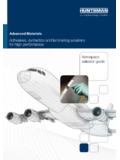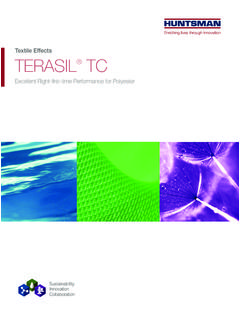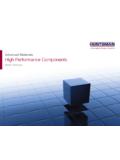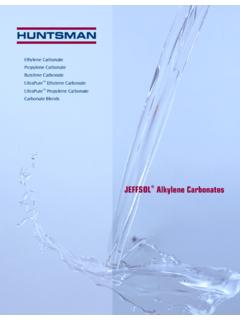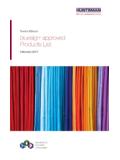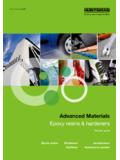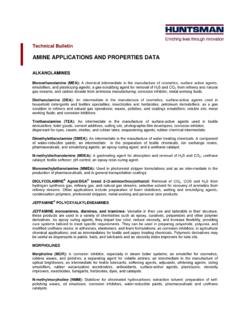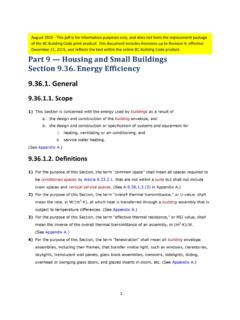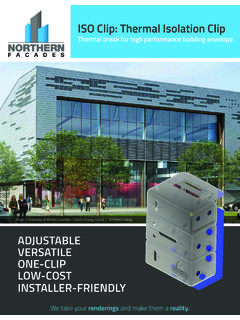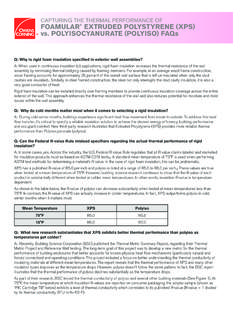Transcription of Accelerated Aging Test Methods for Predicting the …
1 Accelerated Aging Test Methods for Predicting the Long Term thermal Resistance of Closed-Cell Foam Insulation SACHCHIDA N. SINGH AND PAUL D. COLEMAN Huntsman Advanced Technology Center 8600 Gosling Road The Woodlands, TX 77381 ABSTRACT The accurate estimation of the thermal performance of insulation products used in buildings over their expected lifetime has been a recognized challenge for over 25 years. This is because the lifetime of such products is long, thermal Aging is caused by the diffusion of a multitude of gases, and the insulation product is not homogeneous.
2 The task of developing a standard test method for Predicting long term thermal performance which applies to a variety of closed-cell foam products is even more complicated as diffusion processes occur at rates that depend on the type of polymer, the cellular structure, the temperature, the gas type, and its pressure. Both classical approaches to accelerating diffusion controlled phenomena, namely Aging at higher temperature and Aging a thin slice, present challenges especially if a single method is desired for a variety of cellular foam products such as polyisocyanurate (polyiso) and extruded polystyrene (XPS).
3 Though Europe has favored standard test Methods based on Aging at elevated temperature, slicing and scaling techniques have been the leading approach in North America. Lately, two prescriptive test Methods , ASTM C 1303 in the USA and CAN/ULC-S770 in Canada have emerged in North America. Both are based on accelerating the foam Aging process by slicing the foam into thin specimens. Both Methods use the projected thermal conductivity at five years of age to represent the insulations long term thermal resistance value (LTTR).
4 The two Methods have many other similarities, such as use of Fickian law for one-dimensional diffusion to calculate Aging period, and use of a thin slice from the core and surface areas of the foam. However, they do vary in precisely how the long term thermal resistance is calculated. The C 1303 test method prescribes that the thermal resistance value of a stack of thin slices after Aging for a calculated time is the long term thermal resistance value.
5 The S770 test method calls for multiplication of an Aging factor to an initial thermal resistance value to determine the five-year value. Though the basic frameworks of the two Methods are in place, the precise parameters are still being debated and balloted. This paper compares the two Methods , ASTM C 1303-07 and CAN/ULC-S770-03 for their suitability for use as standard test Methods by the polyiso and XPS insulation industry for their boardstock products. Mathematical modeling and calculation algorithms developed by Huntsman and described in earlier papers are used along with published thermal Aging data to evaluate how effective the two Methods will be to meet the various criteria for being an industrially useful method.
6 It looks at the impact on the bias for each of the method for the various parameters still being debated, such as slice thickness and stack composition. This study demonstrates that with the appropriate choice of test conditions, each of the two Methods have potential to give low bias with polyiso boards. For XPS boards, ASTM C 1303-07 appears to be the only real choice. INTRODUCTION Heating and cooling of buildings represents a large fraction of the total energy used by mankind.
7 With the increased cost of fuel and concerns about global warming, there is an increased focus on improving the thermal performance of the building system. Decisions about insulation usage are among the most important an architect or specifier will make relative to the operational cost and environmental impact of a building. To achieve an overall building thermal performance, architects and specifiers know the thermal resistance (R-value) needs for a particular building, component, or component system.
8 They need the manufacturers of building insulation products to supply them with reliable products with high, proven R-values. Among all the insulation products, only polyisocyanurate and extruded polystyrene foam boards are closed celled plastic foams that are designed to capture a gas with much lower thermal conductivity than air. This makes such plastic foam insulation the most efficient insulator among all widely used commercial products. It is the reason why it has the highest growth rate among all insulations globally (1).
9 Due to other requirements on such cellular foam insulations, especially when used in commercial roofing applications, they are not encapsulated in air-tight barriers. This causes the gas composition in the foam to change with time as air diffuses into the foam and the insulating gases diffuse out. The diffusion of some of the gas components is rather slow, leading to gradual shift in R-value over years to even centuries, stopping only when equilibrium concentrations are reached for every gas. This presents a challenge.
10 Certainly architects and specifiers want products that are made using the most advanced materials and process technologies while meeting all the current and anticipated environmental requirements. At the same time, they want to accurately represent the thermal performance. This makes it necessary that there be a relatively short duration, easy to implement and yet technically correct method to measure the thermal performance of closed celled plastics foams for the duration of its use in a building system.
